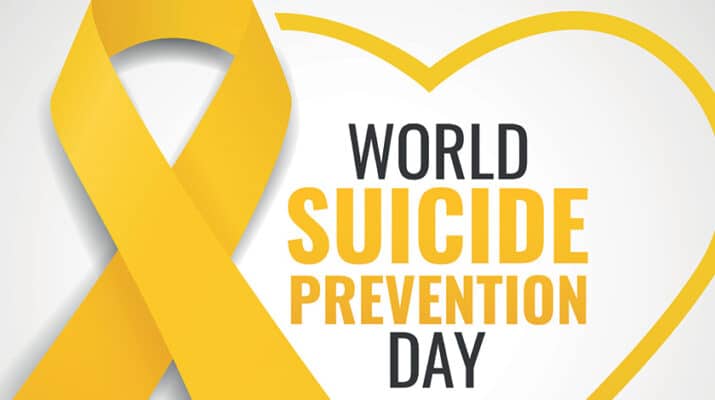CDC: 46,000 Americans died by suicide in 2020
By Deborah Jeanne Sergeant

Sept. 10 is World Suicide Prevention Day. Nearly 46,000 Americans died by suicide in 2020—about one death every 11 minutes, according to the Centers for Disease Control and Prevention.
Although rates declined in 2019 and 2020, it is still a leading cause of death in the United States.
The CDC states that about 12.2 million adults considered suicide, 3.2 million planned an attempt and 1.2 million attempted. In 2020, it was one of the top nine leading causes of death for those aged 10 to 64 and the second leading cause of death for those 10-14 and 25-34.
Anyone who feels a friend or loved one is in imminent danger should call 911 or transport the person to a hospital’s emergency department. For others, it may be only a consideration at this point, but nonetheless it needs to be addressed.
Talking with someone about suicide will not cause that person to attempt it, say experts.
“That’s a myth,” said Anna Shurmatz, licensed clinical social worker in private practice in Buffalo. “Most people who struggle with suicide ideation want someone to ask about it. Part of them doesn’t want to do it. Say, ‘I’m concerned about you. You sound very sad lately. I want you to know how important you are to me and there’s nothing you could say that will make me not care about you.’ Many people don’t know what to say when someone says, ‘I’m struggling with thoughts about ending my life.’”
Shurmatz encourages people to check on family or friends who appear to be struggling. A call, text or visit can provide invaluable encouragement.
Otherwise, people feeling low may not naturally feel valued enough to seek mental healthcare. Offering to make an appointment with a healthcare provider and provide transportation may be enough support to get professional help.
“It’s important for people to give themselves permission to talk about uncomfortable things,” Shurmatz said. “If someone in your life or if you are struggling with thoughts that are scaring you, it’s OK to say that out loud to people or a professional. You’re not going to scare a therapist by saying you’re having these thoughts. No one wants to feel judged.”
Oftentimes, the person suffering has an underlying mental health condition, according to physician Steven Dubovsky, president of UBMD Psychiatry and professor and chairman of the department of psychiatry at Jacobs School of Medicine and Biomedical Sciences.
“Most commonly, it’s depression, bipolar, schizophrenia and certain personality disorders and substance use disorders,” he said. “Those are conditions with the highest risk of suicide.
Receiving treatment for any underlying conditions can help reduce risk of suicide.
People who feel hopeless because of recent grief or loss may lose progress they have made in treating mental health issues.”
Conversely, someone who has struggled with depression for a long time and abruptly states they are fine may have developed a plan for suicide, he added.
“They may think the solution to their problems is suicide,” Dubovsky said.
Talking about suicide frankly and without minimizing their concerns can represent the first step toward seeking professional help. Asking direct questions can help determine the level of risk and then the next step, whether making an appointment with a mental healthcare professional or seeking emergency care.
“If it’s a loved one who says ‘I don’t think life is worth living’ take it seriously,” Dubovsky said. “If you don’t feel comfortable about it, ask who they’ve talked with. Suggest they see a doctor or go to the ER. If they say no and say they’re going to drive into the Niagara River, don’t jump into the car and try to stop them. Call 911.”
He added that talking about suicide will not “make” someone attempt it.
Anyone struggling with thoughts of suicide or who knows someone who is struggling should call 988 or if an emergency 911.
Suicidal Warning Signs
The Mayo Clinic lists as suicidal warning signs:
• Talking about suicide — for example, making statements such as “I’m going to kill myself,” “I wish I were dead” or “I wish I hadn’t been born.”
• Getting the means to take your own life, such as buying a gun or stockpiling pills.
• Withdrawing from social contact and wanting to be
left alone.
• Having mood swings, such as being emotionally high one day and deeply discouraged the next.
• Being preoccupied with death, dying or violence.
• Feeling trapped or hopeless about a situation.
• Increasing use of alcohol
or drugs.
• Changing normal routine, including eating or sleeping patterns.
• Doing risky or self-destructive things, such as using drugs or driving recklessly.
• Giving away belongings or getting affairs in order when there’s no other logical explanation for doing this.
• Saying goodbye to people as if they won’t be seen again.
• Developing personality changes or being severely anxious or agitated, particularly when experiencing some of the warning signs listed above.

